INVENTIONS NOT PATENTABLE
There are some products and processes, which are not patentable in India as per Indian patent Law as described herein.
They are classified into two categories in the patent act
a) Those which are not inventions (S.3) b) Invention relating to atomic Energy (S.4) Various types of non-patentable inventions under Section 3 are as follows- 3(a) An invention which is frivolous or which claims anything obvious contrary to well established natural laws. Merely making in one piece, articles, previously made in two or more pieces is frivolous. Mere usefulness is not sufficient (Indian vacuum brake co. ltd vs. Laurd (AUR 1962 CAK 152). Perpetual motion machine alleged to be giving output without any input is not patentable as it is contrary to natural law. 3(b) An invention the primary or intended use or commercial exploitation of which could be contrary to public order or morality or which causes serious prejudice to human, animal or plant life or health or to the environment 3(c) The mere discovery of a scientific principle or the formulation of an abstract theory or discovery of any living thing or non-living substances occurring in nature; 3(d) The mere discovery of a new form of a known substance which does not result in the enhancement of the known efficacy of that substance or the mere discovery of any new property or new use for a known substance or of the mere use of a known process, machine or apparatus unless such known process results in a new product or employs at least one new reactant. Explanation- For the purposes of this clause, salts, esters, ethers, polymorphs, metabolites, pure form, particle size, isomers, mixtures of isomers, complexes, combinations and other derivatives of known substance shall be considered to be the same substance, unless they differ significantly in properties with regard to efficacy. [Note: Before amendment of Section 3 (d) by the Patents (Amendments) Ordinance 2004 it reads as “mere discovery of any new property or new use for a known substance or mere use of a known process, machine or apparatus…”The insertion of the word “mere” before ‘new use for a known substance’ in this clause by the Patents (Amendment) Ordinance 2004, is for the purpose of drafting clarity only as without it the sub-section would have remained ambiguous. This does not restrict the nonpatentability and give rise to ambiguity and possible misuse. There is no need of giving wider meaning to it.] 3(e) A substance obtained by a mere admixture resulting only in the aggregation of the properties of the components thereof or a process for producing such substance: 3(f) The mere arrangement or re-arrangement or duplication of known devices each functioning independently of one another in a known way. 3(h) A method of agriculture or horticulture. (i) A method of producing a new form of a known plant even if it involved a modification of the conditions under which natural phenomena would pursue their inevitable course is not patentable. (N.V. Philips Gloeiammpenfabrieken's Application 71 RFC 192). 3(i) Any process for the medicinal, surgical, curative, prophylactic diagnostic therapeutic or other treatment of human being or any process for a similar treatment of animals to render them free of disease or to increase their economic value or that of their products. Plants and animals in whole or any part thereof other than microorganisms but including seeds, varieties and species and essentially biological processes for production or propagation of plants and animals; Example: Clones and new variety of plants are not patentable. But process / method of preparing Genetically Modified Organisms are patentable subject matter. 3(m) A mere scheme or rule or method of performing mental act or method of playing game; 3(n) A presentation of information 3(o) Topography of integrated circuits; INVENTIONS RELATING TO ATOMIC ENERGY (S.4) “No Patent shall be granted in respect of an invention relating to atomic energy falling within subsection (1) of section 20 of the Atomic Energy Act, 1962 |
skip to main |
skip to sidebar

Search this site

Total Pageviews
- IPR IN INDIA
- PATENT IN INDIA
- PATENT ACT
- PATENTABILITY CRITERIA
- PATENTABLE INVENTION
- NON-PATENTABLE
- PATENT APPLICATIONS
- PATENT FORMS
- FILING PROCEDURE
- FILING PROCEDURE
- PRE GRANT OPPOSITION
- POST GRANT OPPOSITION
- PATENT TERM
- PATENT OFFICE
- PCT REQUIREMENTS
- REVOCATION OF PATENTS
- CASE LAWS
- PATENT REQUIREMENT
- PATENT INFRINGEMENT
- F A Q
- TREATIES
- PATENT AGENT EXAMINATION
e-mail alerts
Followers
PATENT DATABASE CONCEPTS
PAID DATABASE
Powered by Blogger.
I
P rote©t my
R ight
Translate
PATENT DATABASE
NEWS & UPDATES
Copyright © 2011 Intellectual Property Management | More info about-PATENT IN


















 Posted in:
Posted in: 





















